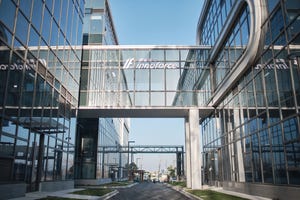
With cell and gene therapies coming of age, experts at Advanced Therapies Week looked to reducing COGs, novel payer models, and even biosimilars to tackle their spiraling price tags.
In 2022, there were 10 approvals between the US and Europe for nine cell and gene therapy products: Adstiladrin, Breyanzi, Carvykti, Ebvallo, Hemgenix (approved by both FDA and EMA), Roctavian, Skysona, Upstaza, Zynteglo.
As such, optimism was high at Phacilitate’s Advanced Therapies Week, held this week in Miami, Florida.

Dark Horse CEO Anthony Davies (right) talks to Michael Meyers (left) and Steven Miller (center) at Advanced Therapies Week in Miami, FL
“We’ve gone from two [approvals] in 2019 to 10 in 2022 (including the overlaps) – that’s a five-fold increase in commercial approvals over the last three or four years,” Anthony Davies, founder & CEO of Dark Horse Consulting Group, said in his opening remarks of the superplenary session.
“If you apply what you might refer to as ‘Gottlieb mathematics,’ I think that shows that we are heading towards the number of commercial approvals by 2025 a year that Scott Gottlieb predicted quite a few years ago when he was the Commissioner of the Food and Drug Administration (FDA).”
Gottlieb’s comments came in January 2019, but the following year his prediction that up to 20 CGT products would be approved per year by 2025 seemed doubtful to come to fruition amid an industry plagued with manufacturing issues and a scarcity of new commercial products.
“The way the field is going, this is becoming a commercial field. At my consulting practice we like NDAs [New Drug Applications] and CTAs [Clinical Trial Applications], but we greatly prefer BLAs [Biologics License Applications] and MAAs [Marketing Authorization Applications].
“The reason we prefer them is that is the authorization for a physician to prescribe a drug to a patient. You don’t have to get on a clinical trial, your drug is not being tested. It’s a commercial product with the best regulators in the world finding it to be safe and effective.”
Yescarta, the bargain basement CGT!
The regulatory success of cell and gene therapies is, however, marred by their escalating price tags.
“Who would have thought it when I stood here in 2018 that Yescarta, with a price tag of $375,000 would literally be the bargain basement cell and gene therapy,” said Davies. We’ve now rung the bell at $3.5 million per patient for one of the recently approved therapies. This is a problem.”
And with therapies aimed at higher patient populations reaching commercialization, this problem is only going to get worse. Biomarin’s Roctavian (valoctocogene roxaparvovec), which won EU approval last year and is tipped to get the US FDA thumbs up in 2023, is a one-off treatment for hemophilia A. In the US alone, upwards of 30,000 people have hemophilia; a far cry from minimal patient populations earlier CGTs set out to treat.
According to Michael Meyers, head of M&A and Strategic Advisory Services of HC Wainwright, Roctavian has a total addressable market of $30-35 billion ($10 billion in its first indication).
While he told Davies industry must play its part by reducing cost of goods sold (COGS), he also said payers are going to extraordinary lengths to revolutionize their payment models. For example, he spoke of private-public partnerships and health insurance risk pools where medical costs are combined to calculate premiums:
He added pricing “will sort out” as more therapies reach the market taking the pragmatic investment-industry perspective: “Where there’s an opportunity to make money and an opportunity to save money, the two will meet.”
Steven Miller, SVP and chief medical officer at pharmacy benefit management organization Express Scripts, meanwhile, told delegates removing waste could open up greater therapy adoption.
“There is enough money in the healthcare system to pay for cell and gene therapies, there’s no doubt about it. We put over $4 trillion of healthcare payment in the marketplace every year. One third of it is waste. If we can find that waste, get that waste out, that money can be reallocated for other things, like cell and gene therapies.”
As an example, he said many states block the adoption of cheaper biosimilars through “horrible policies” such as non-medical switching, wasting billions of dollars.
This led Davies to ask Professor Peter Zandstra from the University of British Columbia whether biosimilar versions of cell and gene therapies could be another potential – yet far-off – way to reduce prices.
“We should be able to get there,” said Zandstra. “Part of the discussion will be how we define biosimilars in the cell and gene therapy space. Biosimilar is the outcome, not necessarily the product, and that might be a different concept that needs to be defined.”
About the Author
You May Also Like

schedl_b_and_w.jpg?width=100&auto=webp&quality=80&disable=upscale)
schedl_b_and_w.jpg?width=400&auto=webp&quality=80&disable=upscale)






